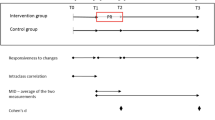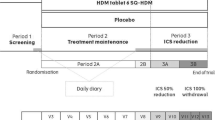Summary
There is a growing body of evidence showing that the conventional clinical indices of asthma severity (airway calibre, symptoms, airway responsiveness, etc.) correlate only weakly with how patients are actually feeling and how they are able to function in their daily lives because of their asthma. When assessing and treating asthma, it is certainly important to evaluate the airways. However, it is equally important to evaluate the impact of the condition on the patients themselves.
There are now a number of health-related quality-of-life instruments, with strong measurement properties, that may be used in both clinical studies and practice. They provide scientifically sound and valid information about patients’ experience that complements conventional clinical measures.
Similar content being viewed by others
References
Juniper EF, Guyatt GH, Ferrie PJ, et al. Measuring quality of life in asthma. Am Rev Respir Dis 1993; 147: 832–8
Marks GB, Dunn SM, Woolcock AJ. An evaluation of an asthma quality of life questionnaire as a measure of change in adults with asthma. J Clin Epidemiol 1993; 46: 1103–11
Rowe BH, Oxman AD. Performance of an asthma quality of life questionnaire in an outpatient setting. Am Rev Respir Dis 1993; 148: 675–81
Juniper EF, Johnston PR, Borkhoff CM, et al. Quality of life in asthma clinical trials: comparison of salmeterol and salbutamol. Am J Respir Crit Care Med 1995; 151: 66–70
Juniper EF, Guyatt GH, Epstein RS, et al. Evaluation of impairment of health-related quality of life in asthma: development of a questionnaire for use in clinical trials. Thorax 1992; 47: 76–83
Marks GB, Dunn SM, Woolcock AJ. A scale for the measurement of quality of life in adults with asthma. J Clin Epidemiol 1992; 45: 461–72
Hyland ME, Finnis S, Irvine SH. A scale for assessing quality of life in adult asthma sufferers. J Psychosomatic Res 1991; 35: 99–110
Creer TL, Wigal JK, Kotses H, et al. A life activities questionnaire for adult asthma. J Asthma 1992; 29: 393–9
Townsend M, Feeny DH, Guyatt GH, et al. Evaluation of the burden of illness for pediatric asthmatic patients and their parents. Ann Allergy 1991; 67: 403–8
Christie MJ, French D, Sowden A, et al. Development of child-centred disease-specific questionnaires for living with asthma. Psychosom Med 1993; 55: 541–8
Nocon A. Social and emotional impact of childhood asthma. Arch Dis Child 1991; 66: 458–60
Usherwood TP, Scrimgeour A, Barber JH. Questionnaire to measure perceived symptoms and disability in asthma. Arch Dis Child 1990; 65: 779–81
Stewart AL, Hays R, Ware JE. The MOS short-form general health survey: reliability and validity in a patient population. Med Care 1988; 26: 724–32
Bergner M, Bobbitt RA, Carter WB, et al. The sickness impact profile: development and final revision of a health status measure. Med Care 1981; 19: 787–805
Hunt SM, McKenna SP, McEwen J, et al. A quantitative ap. proach to perceived health status: a validation study. J Epidemiol Community Health 1980; 34: 281–6
Sackett DL, Chambers LW, MacPherson AS, et al. The development and application of indices of health: general methods and summary of results. Am J Public Health 1977; 67: 423–8
Torrance GW. Measurement of health state utilities for economic appraisal. J Health Econ 1986; 5: 1–30
Mehrez A, Gafni A. The health-years equivalents: how to measure them using the standard gamble approach. Med Decis Making 1991; 11: 140–6
Juniper EF, Guyatt GH, King DR. Comparison of methods for selecting items for a disease-specific quality of life questionnaire: importance versus factor analysis. Qual Life Res 1994; 3: 52–3
Guyatt GH, Kirshner B, Jaeschke R. Measuring health status: what are the necessary measurement properties? J Clin Epidemiol 1992; 45: 1341–5
Streiner DL, Norman GR. Reliability. In: Health measurement scales: a practical guide to their development and use. Oxford: Oxford University Press, 1989: 79–96
Guyatt GH, Walter S, Norman G. Measuring change over time: assessing the usefulness of evaluative instruments. J Chron Dis 1987; 40: 171–8
Lydick E, Epstein RS. Interpretation of quality of life changes. Qual Life Res 1993; 2: 221–6
Juniper EF, Guyatt GH, Willan A, et al. Determining a minimal important change in a disease-specific quality of life questionnaire. J Clin Epidemiol 1994; 47: 81–7
Rutten-van Möiken MPMH, Clusters F, Van Doorslaer EKA, et al. Comparing the performance of four different instruments in evaluating the effects of salmeterol on asthma quality of life. In: Rutten-van Mölken MPMH, editor. Cost and effects of pharmacotherapy in asthma and COPD [thesis]. Maastricht: Universitaire Pers Maastricht, 1994
Bousquet J, Knani J, Dhivert H, et al. Quality of life in asthma: I. Internal consistency and validity of the SF-36 questionnaire. Am J Respir Crit Care Med 1994; 149: 371–5
Jones PW, Nedocromil Sodium Quality of Life Study Group. Quality of life, symptoms and pulmonary function in asthma: long-term treatment with nedocromil sodium examined in a controlled multi centre trial. Eur Respir J 1994; 7: 55–62
Hyland ME. The living with asthma questionnaire. Respir Med 1991; 85: 13–6
Norman GR, Streiner DL. Principal components and factor analysis. In: Biostatistics: the bare essentials. St Louis (MO): Mosby Year Book, Inc., 1994: 129–42
Guyatt GH, Berman LB, Townsend M, et al. A measure of quality of life for clinical trials in chronic lung disease. Thorax 1987; 42: 773–8
Palmer JBD, Hyland ME. Salmeterol in clinical practice: comparator and safety studies, quality of life studies. Eur Respir Rev 1991; 1: 301–3
Hyland M. Antiasthma drugs: quality of life rating scales and sensitivity to longitudinal change. PharmacoEconomics 1994; 6: 325–9
Hyland ME, Kenyon CAP, Jacobs PA. Sensitivity of quality of life domains and constructs to longitudinal change in a clinical trial comparing salmeterol with placebo in asthmatics. Qual Life Res 1994; 3: 121–6
Jones PW, Quirk FH, Baveystock CM, et al. A self-complete measure of health status for chronic airflow limitation; the St. George’s Respiratory Questionnaire. Am Rev Respir Dis 1992; 145: 1321–7
Jones PW, Lasserson D. Relationship between changes in St. George’s Respiratory Questionnaire score and patient perception of treatment efficacy after one year of therapy with nedocromil. Am J Respir Crit Care Med 1994; 149: A211
Maille AR, Kaptein AA, Koning CJM, et al. Developing a quality of life questionnaire for patients with respiratory illness. Monaldi Arch Chest Dis 1994; 49: 76–8
Hyland ME, Ley A, Fisher DW, et al. Measurement of psychological distress in asthma and asthma management programs. Br J Clin Psychol. In press
Coulton T. Nonparametric methods. In: Statistics in medicine. Boston: Little, Brown & Co., 1974: 219–26
Juniper EF, Guyatt GH, Feeny DH, et al. Measuring quality of life (QOL) in children with asthma [abstract). J Allergy Clin Immunol 1995; 95: 226
Creer TL, Wigal JK, Kotses H, et al. A life activities questionnaire for childhood asthma. J Asthma 1993; 30: 467–73
French DJ, Christie MJ, Sowden AJ. The reproducibility of the childhood asthma questionnaires: measures of quality of life for children with asthma aged 4 — 16 years. Qual Life Res 1994; 3: 215–24
Juniper EF, Guyatt GH, Griffith LE, et al. Should the parent or the child be asked about changes in the child’s asthma status? [abstract] Am J Respir Crit Care Med 1995; 151: A589
Guillemin F, Bombardier C, Beaton D. Cross-cultural adaptation of health-related quality of life measures: literature review and proposed guidelines. J Clin Epidemiol 1993; 46: 1417–32
Author information
Authors and Affiliations
Rights and permissions
About this article
Cite this article
Juniper, E.F. Quality-of-Life Considerations in the Treatment of Asthma. Pharmacoeconomics 8, 123–138 (1995). https://doi.org/10.2165/00019053-199508020-00004
Published:
Issue Date:
DOI: https://doi.org/10.2165/00019053-199508020-00004




